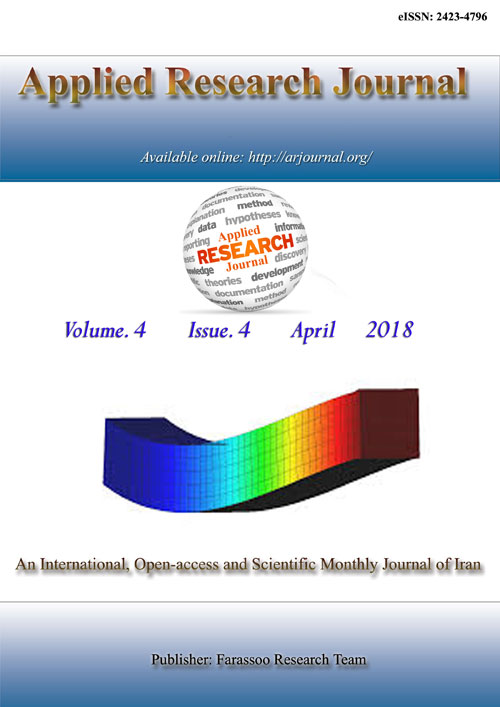فهرست مطالب
Applied Research Journal
Volume:2 Issue: 7, Jul 2016
- تاریخ انتشار: 1395/05/05
- تعداد عناوین: 4
-
Pages 301-306The objective of this research was to analyze the characteristic of mozzarella cheese made from Pampangan buffalo milk comprising of chemical composition, microbiology quality, amino acid and fatty acid content. Mozzarella cheese was manufactured at two treatments i.e. by adding rennet 0.04 g/liter of milk (P1) and 0.06 g/liter of milk (P2). The result showed that P1 and P2 treatments had significant different result on protein and moisture content. After stored for 30 days, no significant different found in P1 and P2 treatment in term of protein content, moisture content, fat content, ash content and total plate count (TPC). Cheese quality during 30 days storage showed that P1 treatment had significant different in term of moisture content and TPC, where P2 treatment had significant different in term of moisture content, protein content and TPC. Total microbe found mozzarella cheese during 30 days storage increased from 4.18 ± 0.16 log cfu/gram to 5.78 ± 0.25 log cfu/gram. Based on the result, it can be concluded that the quality of mozzarella cheese manufactured with different rennet produced different protein and moisture content. There were quality degradation during storage. Total bacteria increased by more than 1 log cfu/gram during storage. There were 15 types of amino acid with glutamic acid as the highest content found in mozzarella cheese made by Pampangan buffalo milk. There were 26 types of fatty acid content found in the mozzarella cheese. The highest content of saturated fatty acid was palmitic acid and the highest content of unsaturated fatty acid was oleic acid.Keywords: Mozzarella cheese, Pampangan buffalo milk, amino acid, fatty acid
-
Pages 307-319An obvious first step in aligning regulatory policies with sustainable housing goals is to correct regulations and provisions. The paper stands on a hypothesis that there is a need to regularly update the building regulations to improve standards of building performance and to accommodate contemporary issues such as sustainability to be applicable. So the objective is to enabling successful application of sustainable housing development criteria within relevant local building regulations and codes through developing an assessment criteria tool by integrating sustainability applications into these regulations. The methodology is adopting an inductive scientific analytical approach to prove the research hypothesis by review on past literature to build the theoretical basis of the research; interviews with experts, then a survey been conducted for case studies consist of housing developments in Iraq to assess the current applied regulations and verify the sustainability requirements within these cases. Then a qualitative and quantitative analysis for results with statistical methods was used. The conclusion is outlining a holistic framework for integrating sustainability into building regulations by identifying differences between the two groups of housing developers: the public and private investment to propose additions and changes to be done on the building regulations according to sustainability criteria.Keywords: Sustainable Housing, Building Regulation, Assessment Criteria, Mann Whitney U, test
-
Pages 320-327Pollution and contamination of farm produce especially vegetables has greatly increase in recent years. Farmer engage in high application of agro chemicals with aim of improving crop yield and reducing hard labor during farming. This chemicals are usually applied without any professional advice, following application specification or having due knowledge on the danger of the chemicals to humans. This has led to a great increase in pollution of agricultural soil and consequently contaminated vegetable and plants through absorption from the soil. In this study, we investigated pollution of soil and vegetable by heavy metals and ions using Atomic Absorption Spectroscopy (AAS) and UV Visible Spectrophotometer. Results from this study show that leaves of vegetable possess the highest level of heavy metals and ions. Among the metals determined, Fe showed the highest concentration with values ranging from 23.02 µg/g to28.09µg/g, while Pb indicates the least concentration with values ranging from 0.2 µg/g-0.8 µg/g. The concentration of ions was also found to be high with values as follows; Na.921 µg/g to 19.21 µg/g, K 16.70 µg/g to 37.11 µg/g, Ca 2 4.94 µg/g to 15.47 µg/g, NO3- 1.07 µg/g to 5.05 µg/g and SO42- 7.52 µg/g to 13.90 µg/g. generally the concentration of this metals and ions in vegetables is in the order of leaves>stem>root, while the concentration in soil is in the order of 20-30cm, 10-20cm>0-10cm. the concentration of this metals and ions were found to be higher than the recommended limit with signifies contamination of the soil and vegetables.Keywords: Physicochemical Characteristics, Heavy Metals, Ions, Soil, Vegetables, Kwaya, Kusar, Borno State
-
Pages 328-335It is very important to determine the layer/ layers because the rutting distress in the highways pavement those suffer from rutting distress, so an accurate rehabilitation strategy is selected. In this study, the Ground Penetrating Radar (GPR) used in detection of rutting distress that Al-Kut Baghdad rural highway suffers from, using 800 MHz antenna. The selected highway suffers from excessive rutting (2-4 cm). According to the processed GPR data, it is discovered that the sub-base layer causes the rutting in the pavement. The GPR results led to a need of conduction of a structural evaluation to the sub-base layer by conducting CBR test, the CBR result of the sub-base layers is (18.7 Mpa) while the Iraqi specification for roads and bridges (SCRB, 2003) state that minimum CBR value for the sub-base type B is (35 Mpa), this result confirmed the GPR results.Keywords: Rutting Detection, Asphalt Pavement, GPR, AlKut, Baghdad Rural Highway


